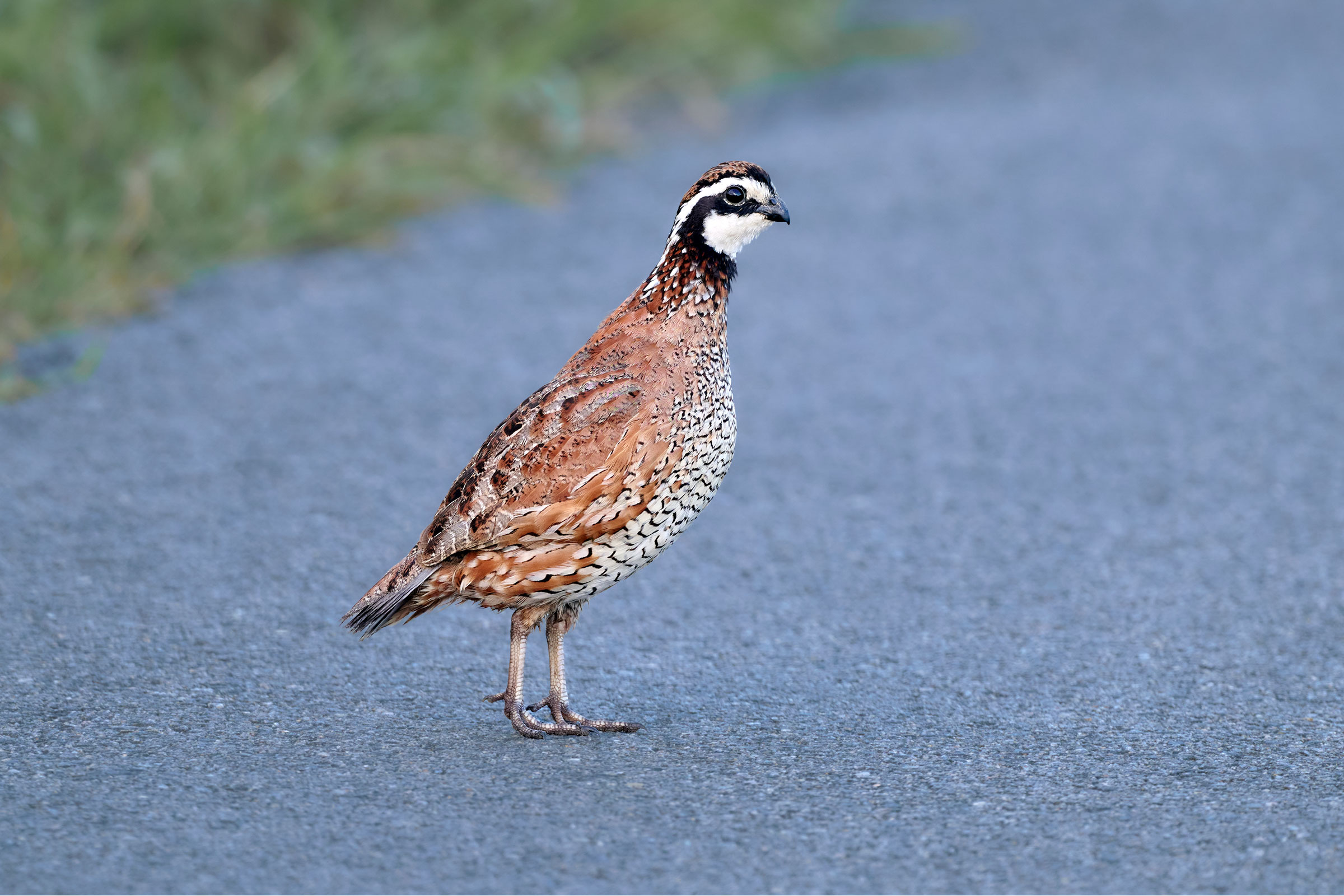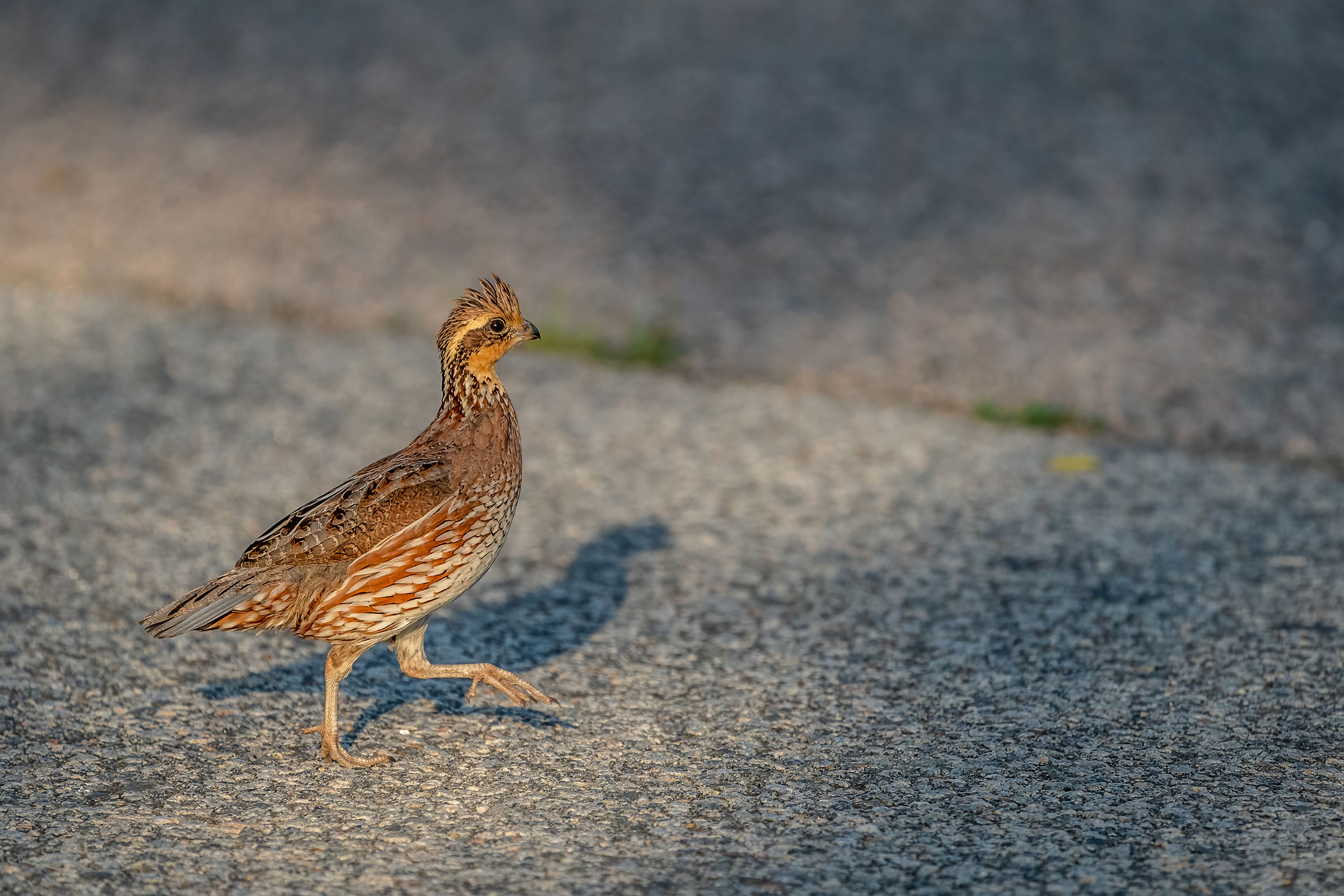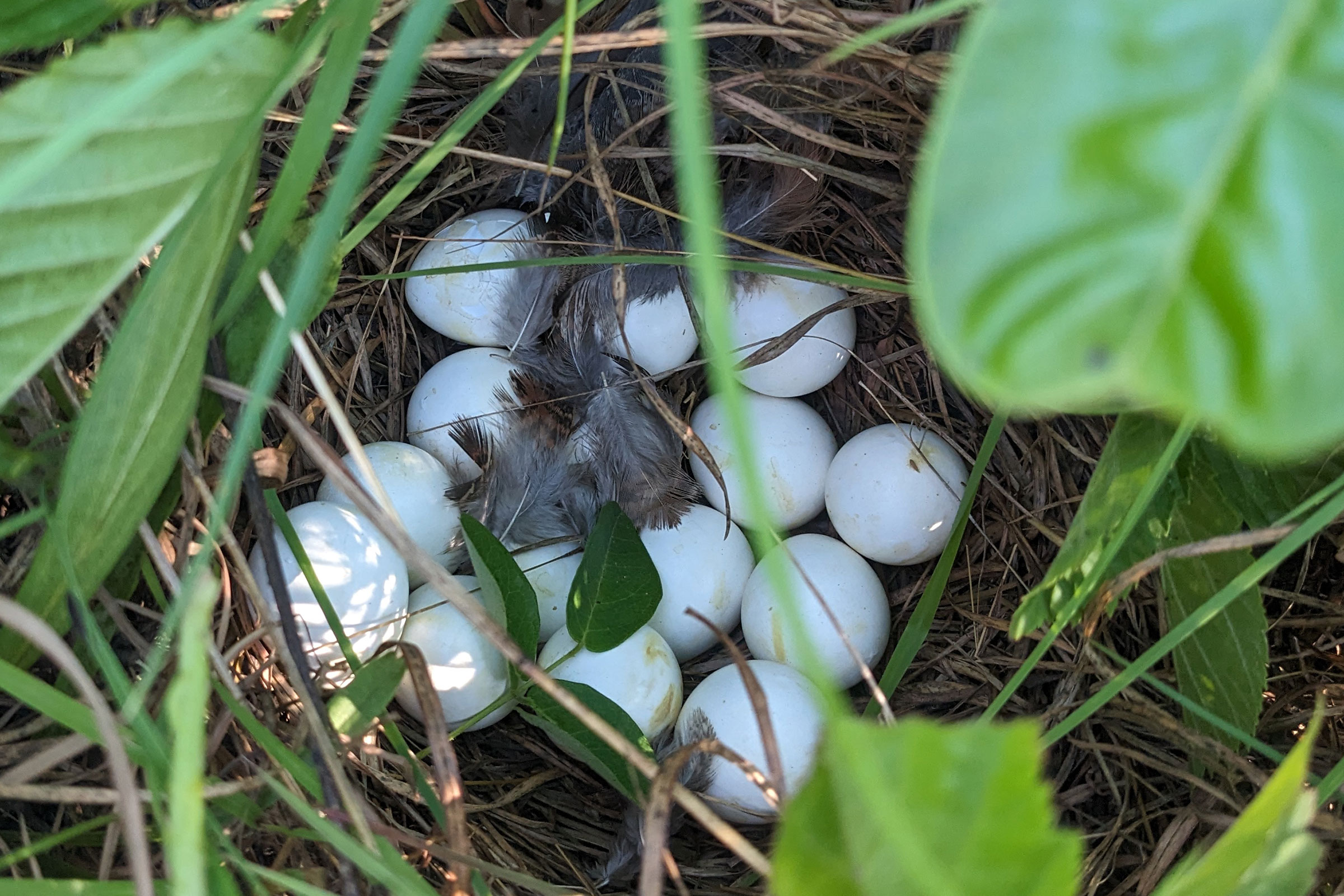Introduction
The Northern Bobwhite’s clear bob-white was once among the most common sounds of the Virginia countryside. Today, Northern Bobwhites are comparatively rare in the state, with populations declining by more than four percent annually since the 1980s (Norman and Puckett 2007). Changes in land use and land management have been the primary drivers of decline in the species. However, their populations likely hit rock bottom in the early 2000s and have been recovering to some degree in areas such as southside and southeastern Virginia and in several counties such as King and Queen and Richmond on the Middle Peninsula and the Northern Neck.
Breeding Distribution
Northern Bobwhites are found in all regions of Virginia, but their distribution is strongly tied to open habitats in the Coastal Plain, southern Piedmont, and southwestern Cumberland Mountains. They are most likely to occur in Brunswick, Buckingham, Campbell, Charlotte, Dinwiddie, Lee, Luneburg, Mecklenburg, Pittsylvania, Southampton, Surry, and Sussex Counties (Figure 1). The likelihood of finding Northern Bobwhites in a block increases with the presence of open shrubland and grassland habitats, such as regenerating agricultural fields and areas with recent pine harvests, and in areas with a greater number of habitat types.
Between Atlases (Figures 1 and 2), the Northern Bobwhite’s likelihood of occurrence decreased substantially throughout much of the state, with the exception of the aforementioned counties in the central and southern Piedmont and southwestern Coastal Plain regions, where they remained mostly stable (Figure 3).

Figure 1: Northern Bobwhite breeding distribution based on probability of occurrence (Second Atlas, 2016–2020). This map indicates the probability that this species will occur in an Atlas block (an approximately 10 mi2 [26 km2] survey unit) based on environmental (including habitat) factors and after adjusting for the probability of detection (variation in survey effort among blocks).

Figure 2: Northern Bobwhite breeding distribution based on probability of occurrence (First Atlas, 1985–1989). This map indicates the probability that this species will occur in an Atlas block (an approximately 10 mi2 [26 km2] survey unit) based on environmental (including habitat) factors and after adjusting for the probability of detection (variation in survey effort among blocks). Blocks in white were not surveyed during the First Atlas and were not modeled.
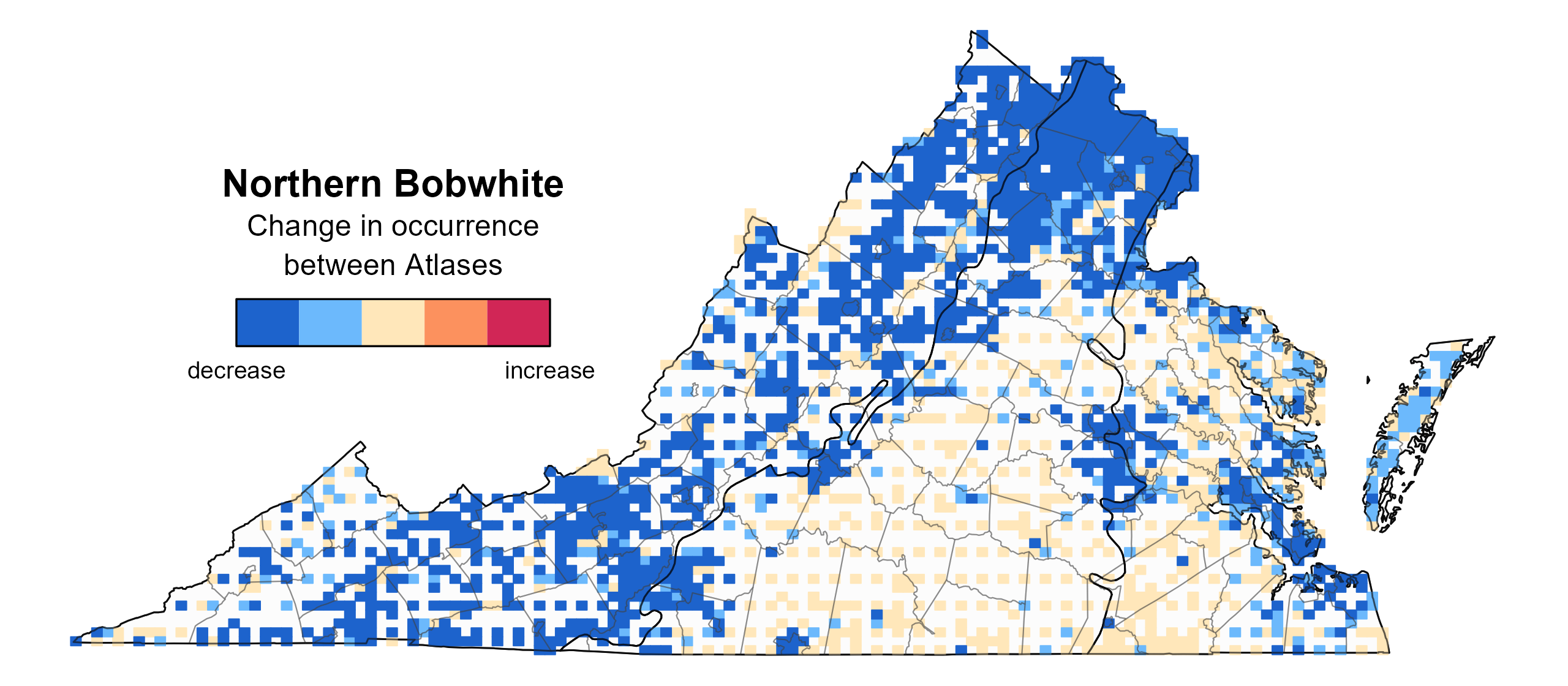
Figure 3: Northern Bobwhite change in breeding distribution between Atlases (1985–1989 and 2016–2020) based on probability of occurrence. This map indicates the change in the probability that this species will occur in a block (an approximately 10 mi2 [26 km2] survey unit) between Atlas periods. Blocks with no change (tan) may have constant presence or constant absence. Blocks in white were not surveyed during the First Atlas and were not modeled.
Breeding Evidence
Northern Bobwhite were confirmed breeders in 22 blocks and 18 counties and probable breeders in an additional 49 counties (Figure 4). Substantially fewer breeding confirmations were recorded in the Mountains and Valleys region and the northern Piedmont region in the Second Atlas than in the First Atlas, which is consistent with their the species’ population decline in the state (see Population Status section; Figure 5).
A combination of naturally camouflaged plumage and well concealed ground nests make it difficult to document breeding evidence. Thus, only one occupied nest was discovered (Figure 6). All other confirmed breeding evidence was documented through observations of recently fledged young (May 15 – September 26) and adult distraction displays (Figure 4).
For more general information on the breeding habits of this species, please refer to All About Birds.
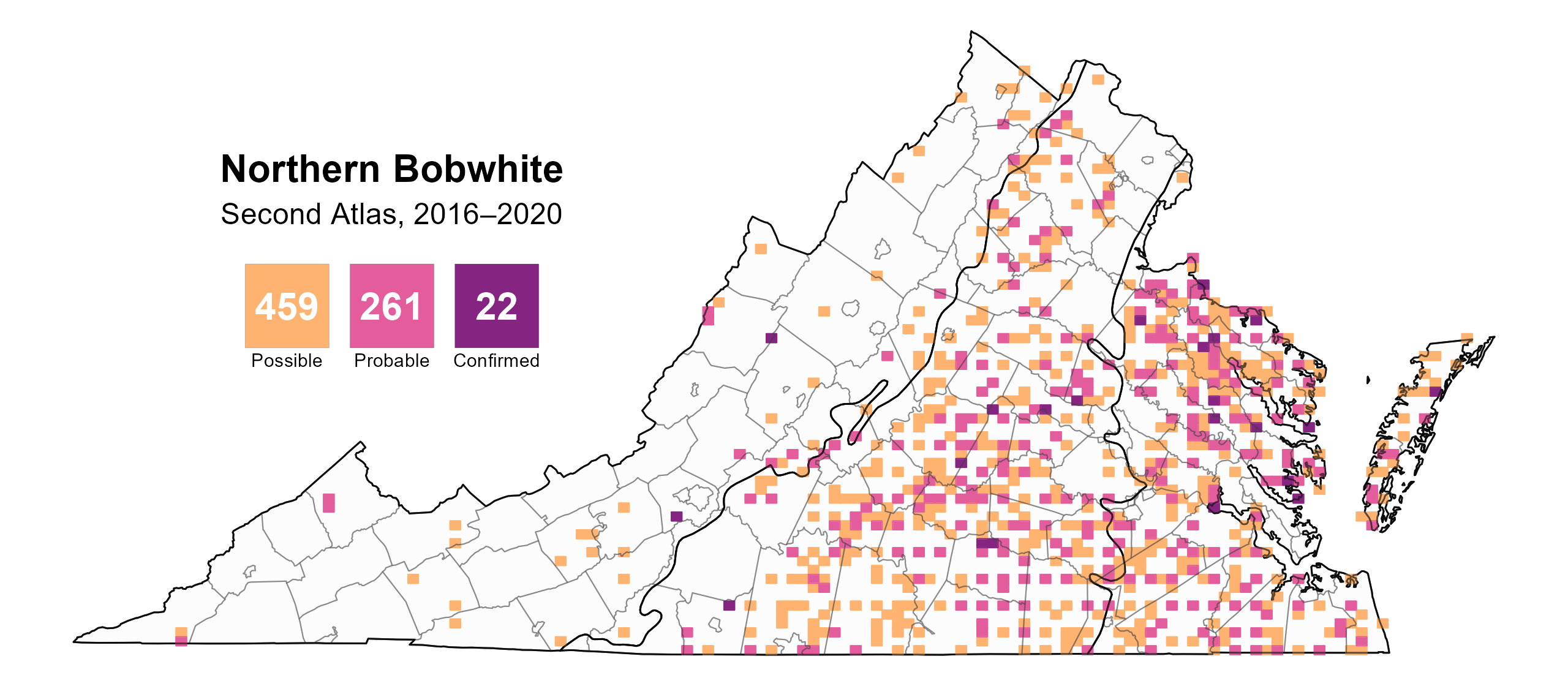
Figure 4: Northern Bobwhite breeding observations from the Second Atlas (2016–2020). The colored boxes illustrate Atlas blocks (approximately 10 mi2 [26 km2] survey units) where the species was detected. The colors show the highest breeding category recorded in a block. The numbers within the colors in the legend correspond to the number of blocks with that breeding evidence category.

Figure 5: Northern Bobwhite breeding observations from the First Atlas (1985–1989). The colored boxes illustrate Atlas blocks (approximately 10 mi2 [26 km2] survey units) where the species was detected. The colors show the highest breeding category recorded in a block. The numbers within the colors in the legend correspond to the number of blocks with that breeding evidence category.

Figure 6: Northern Bobwhite phenology: confirmed breeding codes. This graph shows a timeline of confirmed breeding behaviors. Tick marks represent individual observations of the behavior.
Population Status
Northern Bobwhite relative abundance was estimated to be highest in the southern Piedmont and Coastal Plain regions (Figure 7).
The total estimated Northern Bobwhite population in the state approximately 173,000 individuals (with a range between 92,000 and 341,000). Based on the North American Breeding Bird Survey (BBS), the Northern Bobwhite population decreased by a significant 4.28% annually from 1966–2022 in Virginia. The rate of decrease in the population between Atlas periods was even greater at an estimated significant 5.49% per year from 1987–2018 (Hostetler et al. 2023; Figure 8).

Figure 7: Northern Bobwhite relative abundance (Second Atlas, 2016–2020). This map indicates the predicted abundance of this species at a 0.4 mi2 (1 km2) scale based on environmental (including habitat) factors. Abundance values are presented on a relative scale of low to high.

Figure 8: Northern Bobwhite population trend for Virginia as estimated by the North American Breeding Bird Survey. The vertical axis shows species abundance; the horizontal axis shows the year. The solid line indicates the estimated population trend; there is a 97.5% probability that the true population trend falls between the dashed lines. The shaded bars indicate the First and Second Atlas periods.
Conservation
Changes in agricultural practices toward large and intensively managed farms and large pine plantations and the loss of shrubland and native grassland habitats have degraded or eliminated nesting habitat for Northern Bobwhite in Virginia (Norman and Puckett 2007). Given this loss of habitat and the species’ decline in the state, the 2025 Virginia Wildlife Action Plan includes the Northern Bobwhite as a Tier III Species of Greatest Conservation Need (High Conservation Need), indicating that conservation actions are needed to help increase the population (VDWR 2025). Additionally, organizations such as Quail Forever and The National Bobwhite and Grassland Initiative are working with Virginia Department of Wildlife Resources’ (VDWR) Quail Recovery Initiative to establish habitat on public and private lands. For example, a partnership in Sussex County seeks to restore thousands of acres of Northern Bobwhite habitat on adjoining VDWR Wildlife Management Areas and The Nature Conservancy’s Piney Grove property.
Interactive Map
The interactive map contains up to six Atlas layers (probability of occurrence for the First and Second Atlases, change in probability of occurrence between Atlases, breeding evidence for the First and Second Atlases, and abundance for the Second Atlas) that can be viewed one at a time. To view an Atlas map layer, mouse over the layer box in the upper left. County lines and physiographic regional boundaries (Mountains and Valleys, Piedmont, and Coastal Plain) can be turned on and off by checking or unchecking the box below the layer box. Within the map window, users can hover on a block to see its value for each layer and pan and zoom to see roads, towns, and other features of interest that are visible beneath a selected layer.
View Interactive Map in Full Screen
References
Brennan, L. A., F. Hernandez, and D. Williford (2020). Northern Bobwhite (Colinus virginianus), version 1.0. In Birds of the World (A. F. Poole, Editor). Cornell Lab of Ornithology, Ithaca, NY, USA. https://doi.org/10.2173/bow.norbob.01.
Hostetler, J. A., J. R. Sauer, J. E. Hines, D. Ziolkowski, and M. Lutmerding (2023). The North American breeding bird survey, analysis results 1966–2022. U.S. Geological Survey, Laurel, MD, USA. https://doi.org/10.5066/P9SC7T11.
Norman, G. and M. Puckett (2007). Northern Bobwhite Quail action plan for Virginia. Virginia Department of Wildlife Resources. Henrico, VA, USA. https://www.landcan.org/pdfs/quail-action-plan.pdf.
Virginia Department of Wildlife Resources (VDWR) (2025). Virginia wildlife action plan. Virginia Department of Wildlife Resources, Henrico, Virginia, USA. 506 pp.

